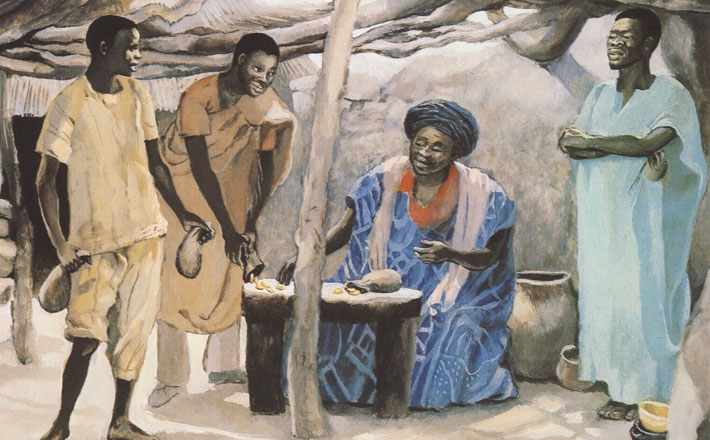Commentary on Judges 4:1-7
The book of Judges features the stories of six major military leaders in Israel called “judges.”
Before the rise of kings in Israel, God raised up these temporary warriors to rescue a loose coalition of Israelite tribes from a series of oppressive enemies. The events in each judges story follow a similar cyclical pattern outlined in Judges 2:11-19:
- Israel sins and worships other gods while living in Canaan.
- God becomes angry and allows enemies to attack Israel.
- The Israelites cry out in pain because of the attack, and God has pity on them. No repentance here, just pain.
- God raises up a judge who delivers Israel and returns the people to proper worship of Israel’s God for a time.
- When the judge dies, the Israelites return to their old ways. The cycle begins all over again.
Judges 4: Will the real judge please stand up?
Judges 4 presents an interesting variation on the typical pattern of the judges story. Four main characters appear:
- an Israelite woman prophet and “judge” (in the judicial sense of an arbitrator of disputes) named Deborah,
- an Israelite military general named Barak,
- a non-Israelite woman named Jael (a Kenite — non-Israelite), and
- a Canaanite military general named Sisera, head of the enemy army.
Much of the drama and interest in the story is trying to decide who the real “judge” is that God has sent to deliver the Israelites. Is it the prophet Deborah who is the first major character in the story? Or is it Barak, a male military leader like the previous judges in chapter 3? Or is it Jael, a non-Israelite woman, who delivers the decisive hammer blow to the Canaanite enemy general named Sisera? And what might all this mean theologically for preaching this text?
The narrative begins with the death of Israel’s previous judge (Ehud) which then leads to the first stage of the judges cycle: “the Israelites again did what was evil” (Judges 4:1). As a consequence, the LORD allowed the Canaanites led by a Canaanite general named Sisera to oppress the Israelites. What was unique about Sisera’s army is its overwhelming technological superiority: “He had nine hundred chariots of iron” (4:3). Against this powerful enemy, Israel cried out to Israel for help (4:2-3).
Deborah, the “Judge”?
Given the elements in the typical Judges cycle, we would expect Israel’s cry for help to be be followed immediately by God raising up a “judge.” The narrative introduces us first to Deborah — a woman, a prophet, and a respected judge who arbitrates disputes (Judges 4:4-5). In Hebrew, the word “judge” can refer either to a judicial arbitrator or a military leader. So is Deborah also a “judge” in this latter sense?
Barak, the “Judge”?
Deborah is an arbitrator but also the Bible’s first woman prophet, a mouthpiece for the word of God in ancient Israel. Deborah summons a military leader named Barak from the tribe of Naphtali. As a prophet, she conveyed to general Barak a divine command (gather troops against Sisera and his Canaanite army) and a divine promise (“I will give him into your hand” — Judges 4:7).
At this point in the story, the reader may think that perhaps it’s not Deborah who is the “judge” (in the sense of military leader) after all. Perhaps Barak may better fit that label? The lectionary unit concludes at this point (verse 7), just when the story is getting interesting.
Find a way to tell the rest of the story.
For preachers of this text, I would strongly recommend that you extend the lectionary reading at least to verse 10 (if not to the end of the chapter in verse 24). In any case, you will want to find a way to get before your congregation the core elements of the whole story of Judges 4 through the liturgical reading or a retelling in the course of the sermon. Why? Because it is a skillfully told story that keeps you guessing until the end. Who is the judge in the story, the one who delivers Israel? Wrestling with the answer to that question will pay off in theological dividends.
Just when the reader is thinking that perhaps Barak is the hero and judge of the story, Barak insists that Deborah go with him to lead in the battle: “if you will not go with me, I will not go” (Judges 4:8). Deborah agrees to go but warns Barak that the battle will not lead to his glory for “the LORD will sell Sisera [the enemy Canaanite general] into the hand of a woman.” A woman? Aha! Perhaps Deborah is the “judge” after all?
Jael the “Judge”?
As you read the rest of the chapter, a new and unlikely candidate for hero and judge emerges. Her name is Jael, a non-Israelite, wife of Heber the “Kenite” (an ethnic designation as well as a word meaning “smith” or worker of iron – Judges 4:11). Jael is related to Hobab the Kenite, the father-in-law of Moses (Judges 1:16). Thus, the reader might initially assume Jael is Israel’s ally. As an iron smith, however, Jael’s husband apparently helped craft the hundreds of iron chariots for Sisera’s army. That connection may explain why Sisera went into Jael’s tent with such confidence seeking security as he fled from his defeated army (Judges 4:17). So whose side is Jael on — Israel or Canaan? The answer comes through a sharp tent peg and a pinging hammer blow to the head of Sisera!
Preaching this violent, edgy text
Several preaching possibilities present themselves.
- Sadly, the human condition across history is often marked by violence and war. The Bible does not ignore or shrink from that tragic truth. The God of Scripture enters into even these messy and tragic conflicts and battles. As God fought for the Israelite slaves in Egypt, so God fights here on the side of the oppressed and less powerful who cry out to God. God fights against those who trust in and worship above all else their own idols of military might and humanly created technology (the Canaanites’ iron chariots; see Isaiah 31:1).
- Human culture often worships singular human heroes. Judges 4 offers another way — interdependence and shared responsibility in reaching a common goal. God works by creating a network of different and often unlikely human agents in order to accomplish the purposes of God. Deborah, Barak, and Jael are brought together by the providence of God. Just as the reader of Judges 4 may in the end not be sure who the true “judge” is in the story, so we may not always be aware of the multiple and sometimes unknown ways in which God is guiding individuals or communities to God’s larger goals. See the apostle Paul’s image of God’s people as “one body” with “many members” (1 Corinthians 12:12-31).
- God often works through unlikely people (1 Corinthians 1:25-31). Jael, a non-Israelite and wife of a blue-color iron-worker, plays a vital role in the victory that God and Israel won against the enemy of God’s people Israel. Deborah — a woman, a prophet, an arbitrator, a military advisor and leader — may also surprise us. Her gender did not stand in the way of God using her in the exercise of power, leadership, and the proclamation of God’s word to her community, even in her ancient and often male-centered world.


November 19, 2017